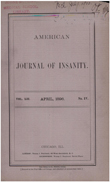Childhood antecedents of adolescent personality disorders
Abstract
OBJECTIVE: The purpose of this study was to investigate the childhood antecedents of personality disorders that are diagnosed in adolescence. METHOD: A randomly selected community sample of 641 youths was assessed initially in childhood and followed longitudinally over 10 years. Childhood behavior ratings were based on maternal report; diagnoses of adolescent personality disorders were based on data obtained from both maternal and youth informants. Four composite measures of childhood behavior problems were used: conduct problems, depressive symptoms, anxiety/fear, and immaturity. Adolescent personality disorders were considered present only if the disorders persisted over a 2-year period. For all analyses, personality disorders were grouped into the three clusters (A, B, and C) of DSM-III-R. RESULTS: Logistic regression analyses indicated that all four of the putative childhood antecedents were associated with greater odds of an adolescent personality disorder 10 years later. Childhood conduct problems remained an independent predictor of personality disorders in all three clusters, even when other childhood problems were included in the same regression model. Additionally, depressive symptoms emerged as an independent predictor of cluster A personality disorders in boys, while immaturity was an independent predictor of cluster B personality disorders in girls. No moderating effects of age at time of childhood assessment were found. CONCLUSIONS: These results support the view that personality disorders can be traced to childhood emotional and behavioral disturbances and suggest that these problems have both general and specific relationships to adolescent personality functioning.
Access content
To read the fulltext, please use one of the options below to sign in or purchase access.- Personal login
- Institutional Login
- Sign in via OpenAthens
- Register for access
-
Please login/register if you wish to pair your device and check access availability.
Not a subscriber?
PsychiatryOnline subscription options offer access to the DSM-5 library, books, journals, CME, and patient resources. This all-in-one virtual library provides psychiatrists and mental health professionals with key resources for diagnosis, treatment, research, and professional development.
Need more help? PsychiatryOnline Customer Service may be reached by emailing [email protected] or by calling 800-368-5777 (in the U.S.) or 703-907-7322 (outside the U.S.).



